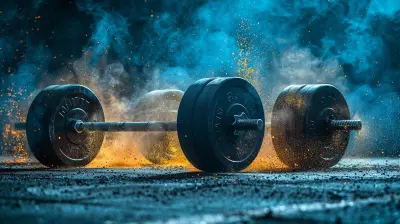The Most Iconic Olympic Torch Relays of All Time
10 June 2025
Ah, the Olympic Torch Relay — it’s that magical journey where fire meets passion, tradition holds hands with innovation, and the countdown to the Games truly begins. Whether it's a flame lighting up the skies from outer space or zipping across vast oceans, the torch relay has become one of the most symbolic and storytelling-rich traditions in sports history.
But not all relays are created equal. Some have stood out for their epic routes, jaw-dropping stunts, or deeper meanings that transcended the sporting world. So sit back, light up your curiosity (not literally, please), and let’s run through the most iconic Olympic Torch Relays of all time.![]()
What Makes an Olympic Torch Relay Special?
Before we sprint into the best of the best, let’s set the scene. The Olympic Torch Relay isn’t just a physical journey. It’s an emotional and symbolic one too. The flame represents purity, the fight for victory, and the continuity between ancient and modern Olympic Games. The relay connects cultures, people, and landscapes in a way few traditions can.But here’s the real kicker — every host nation adds its own spin, using the relay as a storytelling canvas to showcase its culture, tech, and sometimes even its political messages. That’s what makes some of them, well… iconic.![]()
1. Berlin 1936 – The First Ever Olympic Torch Relay
Let’s start with the granddaddy of them all.The 1936 Berlin Olympics marked the very first Olympic Torch Relay. The concept itself was revolutionary back then — take a flame lit in Olympia, Greece, and carry it all the way to the host city. More than 3,000 runners passed the flame across seven countries.
Why was this one “iconic”? Well, it set the blueprint. Without this one, we wouldn’t have the grand, globe-trotting relays we know today. Despite its controversial political undertones due to Nazi propaganda, it laid the groundwork for a tradition that would outshine its origins — quite literally.
_Historical? Yes. Flamboyant? Not quite. Groundbreaking? Absolutely._![]()
2. Barcelona 1992 – The Flaming Arrow Moment
You know that feeling when you watch something unbelievable and then immediately rewind to make sure you didn’t hallucinate? That was Barcelona’s moment in 1992.Instead of the traditional flame-lighting at the cauldron, Spanish Paralympic archer Antonio Rebollo aimed high — like, Olympic-cauldron-on-top-of-the-stadium high — and released a burning arrow.
Did it actually land in the cauldron? Technically, no. The arrow passed over, and a gas mechanism triggered the flame. But honestly, no one cared. It felt like an epic movie moment, and the creativity was off the charts.
_Archery + fire = Olympic magic._![]()
3. Sydney 2000 – A Flame Rises from Water
Australia went full-on theatrical with this one, and it worked.During the opening ceremony, Olympian Cathy Freeman took the torch into a circle of water (yes, water), and as she stood there, a ring of fire rose around her. Slowly, the platform lifted and lit the grand cauldron hovering above the stadium.
Symbolism alert: Freeman is of Aboriginal descent, and her lighting of the flame was seen as a powerful gesture toward reconciliation with Indigenous Australians. It was raw, emotional, and unforgettable.
_This wasn’t just a flame; it was a rising tide of hope and unity._
4. Beijing 2008 – International Highs and Political Lows
Now here’s a relay that was iconic for more than just its visuals.Beijing 2008’s relay was literally called the “Journey of Harmony,” and boy, did it go big — 137,000 km kind of big. The torch traveled to all five continents and even reached the summit of Mount Everest. No small feat, right?
But, it wasn’t all smooth sailing. The relay faced protests around the world over China’s human rights record, especially in Tibet. Some stops were even canceled.
So why is it on this list? Because it showed that the Olympic flame, a symbol of peace, can become a focal point for global activism — a powerful reminder that sport doesn’t exist in a vacuum.
_The flame burned bright, but it also sparked debate._
5. London 2012 – A Fiery Blossom of Unity
London 2012 had a beautifully British approach — elegant, understated, yet deeply meaningful.The relay itself traveled through over 1,000 cities, towns, and villages across the UK. But the real “goosebumps” moment came during the lighting of the cauldron.
Instead of one massive torch, 204 smaller petals — one for each participating nation — were carried in and lit by young athletes. These petals then rose and assembled together to form one giant flame. It was symbolic, poetic, and truly Olympic.
_Talk about lighting the way for the next generation._
6. Sochi 2014 – The Flame That Went (Way) Off Course
Think Russia. Think big. Now think bigger.Sochi’s relay went all out — over 65,000 km of travel, covering even the North Pole, the bottom of Lake Baikal, AND OUTER SPACE. Yup, for the first time, the Olympic torch traveled to space and was taken on a spacewalk. Zero gravity, full symbolism.
There were stumbles though — literally. The flame went out multiple times, even in Moscow’s Kremlin (awkward!). Still, the ambition was unmatched.
_Space. The final torch frontier._
7. Rio 2016 – A Torch Relay of Connection and Contrast
Brazil’s relay was all about contrasts — rich vs poor, old vs new, forest vs cityscape.The flame passed through iconic spots like the Amazon Rainforest, ancient colonial cities, and pulsating urban hubs like São Paulo and Rio. It was a breathtaking reminder of Brazil’s diverse soul.
The opening ceremony saw the torch lit by Vanderlei de Lima, a marathon runner famously attacked during the 2004 Games but who went on to finish and win bronze. The choice was inspiring — a nod to perseverance and grace under pressure.
_When life knocks you off course, just keep running._
8. Tokyo 2020 – A Torch of Resilience
The Tokyo 2020 relay (held in 2021 due to the pandemic) was unlike any other. It took place amid global uncertainty, with health and safety leading every decision.But that didn’t dim its symbolic fire. The torch design was inspired by cherry blossoms, a nod to Japan’s transient beauty and renewal. The route passed through areas affected by the 2011 tsunami and Fukushima disaster — a tribute to the human spirit’s ability to rebuild and rise again.
_Flaming proof that hope doesn’t quarantine._
Honorable Mentions
There are so many torch relays that could’ve made the cut. Here are a few more worth a quick shoutout:- Atlanta 1996: Muhammad Ali lighting the cauldron while battling Parkinson’s — chills.
- Athens 2004: Torch traveled to every city that had hosted the Games before — a full-circle moment.
- PyeongChang 2018: Carried by robots and lit by figure skating legend Yuna Kim. Need we say more?
The Flame That Unites Us All
Each Olympic Torch Relay tells a different story. Some dazzle with tech and creativity, others pull at our heartstrings with powerful symbolism. But no matter where it travels or who carries it, the torch always brings a spark — of unity, peace, hope, and anticipation.The world may change between each Olympic cycle, but one thing remains constant: when that flame is lit, we all feel a little more connected.
So next time you see the torch on your screen or (if you're lucky) pass by your town, remember — it's not just fire. It's history, culture, and dreams wrapped in a dance of flickering light.
Final Thoughts
From arrows in the sky to flames in space, the Olympic Torch Relay has evolved from a simple handoff into a full-blown emotional and visual spectacle. It's one part tradition, one part innovation, and always 100% inspiration. And no doubt, future relays will keep pushing the boundaries and lighting the way forward.Which torch relay is your favorite? Did any moment leave you speechless? Let’s keep the flame of conversation burning in the comments!
all images in this post were generated using AI tools
Category:
OlympicsAuthor:

Onyx Frye
Discussion
rate this article
3 comments
Karly Roth
What a fascinating exploration of Olympic history! Each torch relay seems to carry its own story and spirit. I'm curious—what moments stood out to you as particularly unforgettable?
June 18, 2025 at 3:28 AM

Onyx Frye
Thank you! The iconic moments that stood out to me include the emotional lighting of the torch in Berlin 1936, the unforgettable relay through the streets of Athens for the 2004 Games, and the breathtaking ascent of Mount Olympus in 2000. Each moment truly captured the spirit of the Olympics!
Vanta McKinney
Great article! The history behind each torch relay truly showcases the spirit of the Olympics.
June 15, 2025 at 4:27 AM

Onyx Frye
Thank you! I'm glad you enjoyed exploring the spirit and history behind the torch relays!
Ranger Benton
This article beautifully captures the spirit of the Olympics through unforgettable torch relay moments!
June 13, 2025 at 4:37 AM

Onyx Frye
Thank you! I'm glad you enjoyed the article and appreciated the spirit of the torch relays!



